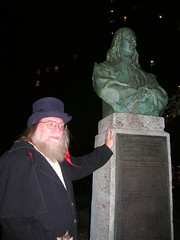 Darla Murray Gordon Linzner, who leads tours of locations that are reportedly haunted in the East Village, with a bust of Peter Stuyvesant.
Darla Murray Gordon Linzner, who leads tours of locations that are reportedly haunted in the East Village, with a bust of Peter Stuyvesant.Have you ever found yourself walking along the Bowery and heard the “clip-clop” of a wooden cane hitting the pavement behind you only to discover no one was there? Or have you developed a photograph snapped at Shelton Cemetery and discovered an unexplained streak of light smeared across it? Or what about a time when you’ve reached down from your stool at McSorley’s Ale House to stroke the cat that brushed up against your leg, then realized the only feline in the pub is asleep twenty feet away in the windowsill?
Phil Schoenberg, a history professor at Queens College by day and a ghost historian by night, can explain.
Mr. Schoenberg and his team of experts offer skeptics and believers 90-minute walking tours of so-called haunted locations of the East Village – an area of Manhattan often overlooked by paranormal enthusiasts who tend to focus on Greenwich Village and Midtown’s Theater District.
“The popular literature will always mention the Merchant’s House,” says Mr. Schoenberg, referring to the oft-cited 19th century red brick rowhouse on East Fourth Street said to be haunted by the former owner’s daughter, “but not much else in the East Village.”
However, when you consider the number of prominent settlers in the area and the neighborhood’s many incarnations, Gordon Linzner, who, like Mr. Schoenberg is a student of local apparitions, says that it should come as no surprise that this part of Manhattan is reportedly haunted.
The tour commences with the introduction to one such settler, Peter Stuyvesant, the last Dutch governor of New York — or New Amsterdam as it was called back in 1647 — and owner of more than 60 acres of property.
In 1672, at the age of 80, Mr. Stuyvesant was laid to rest — but rest he did not, according to haunted lore. Four hundred years after being interred in the floor of his private chapel on the corner of Second Avenue and 10th Street — now the location of St. Marks-in-the-Bowery church — Mr. Stuyvesant is said to still be seen trolling the streets of the East Village, supposedly rankled by the disturbances to his former property. Mr. Linzner says he’s been spotted, and heard meandering along the Bowery, which was once the pathway to his mansion. It’s the tapping of his wooden peg leg and cane on the sidewalk that has been attributed to the aforementioned “clip clop” sound (a sound I heard while touring with Mr. Linzner; alas, the source turned out to be simply a woman’s stiletto clicking along the pavement).
“Some people come on the tours because they want to be spooked and others come to learn about the community’s history,” says Schoenberg. In addition to being made privy to the stories of paranormal activity in the neighborhood patrons of the tour are also provided with many fascinating — and equally scary — bits of historical information. For example Peter Cooper, the famed inventor and founder of Cooper Union, boiled the hooves of the neighborhood’s dead horses to make gelatin, which he patented (and eventually lead to the creation of Jell-O). Also, the memorabilia at McSorley’s — including handcuffs owned by the pub’s most mysterious patron, Harry Houdini, and a collection of wishbones — has not been disturbed since in the early 1900s (the inch-thick dust layer doesn’t lie).
“Of course,” Mr. Schoenberg continues, “there are also those who take part in the tours because they believe.” And there is plenty of fodder for the believers. Mr. Schoenberg’s team has decades’ worth of research to explain why some of the neighborhood’s former residents may have unfinished business here. Uncovering the dark history of the neighborhood’s former residents is Mr. Linzner’s métier. For instance, after hearing stories of an unexplained presence in a walkup building at 25 Bond Street, Mr. Linzner researched the property and learned of a heinous murder, which had occurred there in1857 (a Columbia Law School alum, Benjamin Feldman, researched the property as well and has published a book about the murder).
So while you might be tempted to chalk up that smear in the photograph to a carelessly placed pinky finger on the lens, perhaps it really is a spirit’s orb. And sure, the disappearing cat could be explained by one too many ales, but maybe it actually is an apparition of the black cat rumored to belong to Houdini. The tales Mr. Schoenberg and his fellow guides regale on the tour are all stories about real people who once lived in the East Village – but their existence after death is for you to determine.
Local Haunts
Phil Schoenberg, ghost historian, discusses ghouls in the East Village with NYU Journalism’s Becky Flaum.




